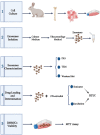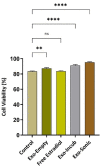17β-Estradiol-Loaded Exosomes for Targeted Drug Delivery in Osteoporosis: A Comparative Study of Two Loading Methods
- PMID: 38022800
- PMCID: PMC10676548
- DOI: 10.34172/apb.2023.072
17β-Estradiol-Loaded Exosomes for Targeted Drug Delivery in Osteoporosis: A Comparative Study of Two Loading Methods
Abstract
Purpose: Exosomes are natural nanoparticles that participate in intercellular communication through molecular transport. Recently, due to their membrane vesicular structure and surface proteins, exosomes have been used extensively in the research field of drug delivery. Osteoporosis is an inflammation in which the cellular balance of bone tissue is disturbed that reduces bone density and making bone prone to abnormal fractures with small amount of force. Utilizing estrogen is one of the main therapeutic strategies for osteoporosis. Despite the positive effects of estrogen on bone tissue, changes in the natural estrogen levels of the body can cause a number of diseases such as different types of cancer. Therefore, designing a therapeutic system which controls more accurate tissue targeting of estrogen seems to be a rational and promising practical approach.
Methods: In this study, bone marrow mesenchymal stem cells (BMMSCs)-derived exosomes were loaded by estradiol using two different methods of drug loading, namely incubation and sonication methods and then the survival effects of the drug loaded exosomes on BMMSCs was investigated.
Results: Examination of size, shape, and surface factors of exosomes in different states (pure exosomes and drug-loaded exosomes) showed that the round morphology of exosomes was preserved in all conditions. However, the particles size increased significantly when loaded by sonication method. The increased survival of BMMSCs was noted with estradiol-loaded exosomes when compared to the control group.
Conclusion: The results suggest that estradiol-loaded exosomes have potential to be used as nano-drug carriers in the treatment of osteoporosis.
Keywords: 17β-estradiol; Bone marrow mesenchymal stem cells; Drug delivery; Exosome; Osteoporosis.
©2023 The Authors.
Conflict of interest statement
The authors declare that they have no conflict of interest.
Figures
Similar articles
-
Paclitaxel incorporated exosomes derived from glioblastoma cells: comparative study of two loading techniques.Daru. 2019 Dec;27(2):533-539. doi: 10.1007/s40199-019-00280-5. Epub 2019 Jul 17. Daru. 2019. PMID: 31317441 Free PMC article.
-
Mesenchymal stem cell‑derived exosomes loaded with 5‑Fu against cholangiocarcinoma in vitro.Mol Med Rep. 2022 Jun;25(6):213. doi: 10.3892/mmr.2022.12729. Epub 2022 May 11. Mol Med Rep. 2022. PMID: 35543159 Free PMC article.
-
Exosomes derived from adipose tissue, bone marrow, and umbilical cord blood for cardioprotection after myocardial infarction.J Cell Biochem. 2020 Mar;121(3):2089-2102. doi: 10.1002/jcb.27399. Epub 2019 Nov 17. J Cell Biochem. 2020. PMID: 31736169
-
Current Knowledge and Future Perspectives of Exosomes as Nanocarriers in Diagnosis and Treatment of Diseases.Int J Nanomedicine. 2023 Aug 21;18:4751-4778. doi: 10.2147/IJN.S417422. eCollection 2023. Int J Nanomedicine. 2023. PMID: 37635911 Free PMC article. Review.
-
The Therapeutic Potential and Clinical Significance of Exosomes as Carriers of Drug Delivery System.Pharmaceutics. 2022 Dec 21;15(1):21. doi: 10.3390/pharmaceutics15010021. Pharmaceutics. 2022. PMID: 36678650 Free PMC article. Review.
Cited by
-
A comprehensive review of challenges and advances in exosome-based drug delivery systems.Nanoscale Adv. 2024 Oct 29;6(23):5803-26. doi: 10.1039/d4na00501e. Online ahead of print. Nanoscale Adv. 2024. PMID: 39484149 Free PMC article. Review.
References
Grants and funding
LinkOut - more resources
Full Text Sources





